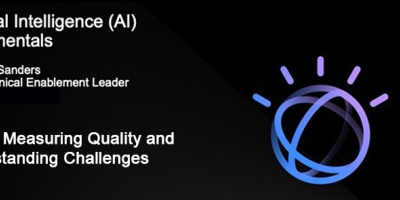As you approach your AI journey, maybe the most helpful thing that you can get is some good, practical advice on how to get started and what to consider important.
Over the past few months, we have looked at how you might get started with AI in your company and how that might affect you, your co-workers, and your company as a whole. So what else can we say?
Well, a little practical advice might be in line.
Don’t Neglect Education/Training
Yep, everybody knows how important education is, and I’m sure it will be one of the first things listed on the project plan. But do these words sound familiar? “We’re in a hurry to get this done for business reasons, so while we’re waiting for the education to be over, let’s just get started with the coding, OK?”
Don’t do that! Do the education and do a thorough job on it. You might even want to set that up as a pre-program, so to speak—that is, as something that should be completed before the actual AI project is started. Doing so might help prevent education from being the first part of the AI project that gets omitted.
Make the Education Effective
Don’t just do any old education in a perfunctory way. People should walk out of whatever education you set up with a solid grip on what AI is (meaning they can explain it to someone else). This is not just definitions; they should be able to feel what business problems they have that AI can address and recognize just how difficult (on a scale of 1–10) that project will be.
Of course, the tricky part is finding the human resources for your AI training. What you need is someone who can explain, in simple yet accurate terms, what AI consists of, what the various components are, what types of problems they can be used to attack, what the technological underpinnings are, and how to structure your project for success. Beware of canned education. Training should definitely be oriented around your business and your issues.
Look Carefully at the Possibilities
Immediately after education, review the issues your company is dealing with and choose some that AI could assist with.
I know that you will probably already have a mental list of problem areas you would like to attack with AI, but don’t announce you are going to solve such and such with AI and then begin the education process. It could be embarrassing because, by the time you get to the end of the education, you might decide that what you were initially pointing at is a bridge too far and you really should start with something more reasonable.
Top management’s natural inclination will be to pick an issue for AI to tackle that’s very broad and hard to get your hands around. For example, when Symrise wanted to bring AI to bear on developing new fragrances, they found it took considerably more time than they expected. The article I linked to doesn’t reveal the specific time frame involved, but it certainly leaves the impression that things took longer than anticipated to yield results. To me, that makes a lot of sense. AI is a complex concept that uses multiple tools and requires a great deal of time to develop. Yes, the results, once AI starts working right, are worth it, but why make the whole process harder by choosing a difficult issue to resolve?
I strongly recommend starting with small projects, things that can be done in a reasonable time period for a reasonable amount of money. There are several reasons for this.
First and most important, it will take the first AI project out from under the microscope—that is, if you use AI to tackle the corporation’s biggest issue, everything you do and every decision you make will be reviewed by literally everyone. That’s a lot of pressure, and it opens the door to some very unhelpful second guessing. Small projects will not face that kind of scrutiny. And that will help the project team stay focused and productive.
Second, one of the real pitfalls with AI is the feeling, after a year has gone by with no finished product, that this is a tremendous waste of money. Small projects limit the scope and the cost and allow you to actually complete something within a reasonable time. It won’t necessarily be reasonable to upper management, but a six-month project with results is better than a three-year project with results.
Third, the end of the education project is not the end of the education process. You will learn so much more when you finally do start to develop. And, as you develop and learn, you will make mistakes. Do yourself a favor and learn those lessons on small projects so that when you’re ready to tackle a big project, you can estimate it correctly and keep progress mostly moving forward.
Don’t Underestimate the Time Required
For this, you need to take all of your experience estimating technical projects and throw it out the window.
AI projects, especially your first few, are incredibly time-intensive.
As data scientist Peter Skomoroch said in the MIT Technology Review article previously mentioned, “As a rule of thumb, you can expect the transition of your enterprise company to machine learning will be about 100x harder than your transition to mobile.” In the same article, Symrise executive Achim Daub, who brought IBM in to shepherd the fragrances AI project, summed it up by saying, “It’s kind of a steep learning curve. We are nowhere near [after two years of work] having AI firmly and completely established in our enterprise system.”
Again, this is why doing a couple of small projects first will really help you see how difficult the estimation process is. You don’t want to be the one who is writing the article as you finish up your now five-year project to install AI, saying that the one thing you wished you’d known was how long the whole process would take.
Especially Machine Learning
What makes AI projects so difficult to estimate?
Well, some of it is in the tools. You will be using a number of them together, and some of them will be new, so it takes time to get your feet on the ground.
And some of it will be getting a really solid understanding of what the problem is. Everyone probably thinks they have an understanding (and perhaps they do), but often when you get into the details of the AI project you realize that your initial assumptions and understanding may have been not quite (or not at all) accurate.
But the big reason for the difficulty in estimating AI projects is the time required for machine learning. I don’t want to spook you or anything, but by itself, the machine really doesn’t know squat.
It will be up to you to train it to, for example, recognize printed or verbal word patterns, visual patterns, etc. In essence, that’s what AI is all about: identifying the key aspects that differentiate success from failure, and then teaching the system to see the difference between those extremes.
In the End
In the end, doing AI will be the most difficult and elusive business and technical challenge your company ever attempts.
That’s not to say you shouldn’t do it. To be perfectly honest, I don’t think you have a choice. We are moving, slowly but inexorably, into a new world where artificial intelligence and the ability to wield it will be decisive in the constant struggle for businesses to survive and evolve.
Good luck.

























 More than ever, there is a demand for IT to deliver innovation. Your IBM i has been an essential part of your business operations for years. However, your organization may struggle to maintain the current system and implement new projects. The thousands of customers we've worked with and surveyed state that expectations regarding the digital footprint and vision of the company are not aligned with the current IT environment.
More than ever, there is a demand for IT to deliver innovation. Your IBM i has been an essential part of your business operations for years. However, your organization may struggle to maintain the current system and implement new projects. The thousands of customers we've worked with and surveyed state that expectations regarding the digital footprint and vision of the company are not aligned with the current IT environment. TRY the one package that solves all your document design and printing challenges on all your platforms. Produce bar code labels, electronic forms, ad hoc reports, and RFID tags – without programming! MarkMagic is the only document design and print solution that combines report writing, WYSIWYG label and forms design, and conditional printing in one integrated product. Make sure your data survives when catastrophe hits. Request your trial now! Request Now.
TRY the one package that solves all your document design and printing challenges on all your platforms. Produce bar code labels, electronic forms, ad hoc reports, and RFID tags – without programming! MarkMagic is the only document design and print solution that combines report writing, WYSIWYG label and forms design, and conditional printing in one integrated product. Make sure your data survives when catastrophe hits. Request your trial now! Request Now. Forms of ransomware has been around for over 30 years, and with more and more organizations suffering attacks each year, it continues to endure. What has made ransomware such a durable threat and what is the best way to combat it? In order to prevent ransomware, organizations must first understand how it works.
Forms of ransomware has been around for over 30 years, and with more and more organizations suffering attacks each year, it continues to endure. What has made ransomware such a durable threat and what is the best way to combat it? In order to prevent ransomware, organizations must first understand how it works. Disaster protection is vital to every business. Yet, it often consists of patched together procedures that are prone to error. From automatic backups to data encryption to media management, Robot automates the routine (yet often complex) tasks of iSeries backup and recovery, saving you time and money and making the process safer and more reliable. Automate your backups with the Robot Backup and Recovery Solution. Key features include:
Disaster protection is vital to every business. Yet, it often consists of patched together procedures that are prone to error. From automatic backups to data encryption to media management, Robot automates the routine (yet often complex) tasks of iSeries backup and recovery, saving you time and money and making the process safer and more reliable. Automate your backups with the Robot Backup and Recovery Solution. Key features include: Business users want new applications now. Market and regulatory pressures require faster application updates and delivery into production. Your IBM i developers may be approaching retirement, and you see no sure way to fill their positions with experienced developers. In addition, you may be caught between maintaining your existing applications and the uncertainty of moving to something new.
Business users want new applications now. Market and regulatory pressures require faster application updates and delivery into production. Your IBM i developers may be approaching retirement, and you see no sure way to fill their positions with experienced developers. In addition, you may be caught between maintaining your existing applications and the uncertainty of moving to something new. IT managers hoping to find new IBM i talent are discovering that the pool of experienced RPG programmers and operators or administrators with intimate knowledge of the operating system and the applications that run on it is small. This begs the question: How will you manage the platform that supports such a big part of your business? This guide offers strategies and software suggestions to help you plan IT staffing and resources and smooth the transition after your AS/400 talent retires. Read on to learn:
IT managers hoping to find new IBM i talent are discovering that the pool of experienced RPG programmers and operators or administrators with intimate knowledge of the operating system and the applications that run on it is small. This begs the question: How will you manage the platform that supports such a big part of your business? This guide offers strategies and software suggestions to help you plan IT staffing and resources and smooth the transition after your AS/400 talent retires. Read on to learn:
LATEST COMMENTS
MC Press Online